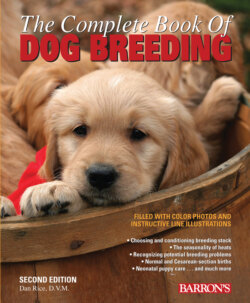Читать книгу The Complete Book of Dog Breeding - Dan Rice - Страница 49
На сайте Литреса книга снята с продажи.
Selecting a Suitable Male
ОглавлениеWe have spent many pages discussing the choice and conditioning of breeding females prior to and at the time of breeding. Now a few words need to be said about your choice of a sire for the new litter. The indisputable fact is, he will contribute half of the puppies’ genetic characteristics.
It goes without saying that you have studied the breed standards and compared them to the conformation, color, and markings of available males. Pedigrees have been studied; if he is a proven sire, his progeny have been evaluated. Final selection might rest on other, rather esoteric values.
• Evaluate his temperament. If possible, meet and handle the prospective sire and all his available adult offspring. Be especially critical of exaggerated aggressiveness or shyness.
• If your bitch has any flaws or faults (heaven forbid!) that have been discovered in the show ring or elsewhere, look for a male that does not duplicate those faults. When evaluating a potential stud dog, identify his faults (there are bound to be a few), and be sure that your bitch does not have similar faults.
• Genetic problems exist in virtually all breeds. To avoid as many as possible of those hereditary deformities and diseases, contact the Canine Health Information Center (CHIC) and avail yourself of that organization’s DNA registry. (See page 45.)
• Health considerations are extremely important. If breeding to a show animal, you will probably find him in excellent condition. If not, be sure he appears strong and vital. His coat should shine; he should be well muscled and active. His eyes should be clear and bright, and he should display a natural curiosity when you meet him.
